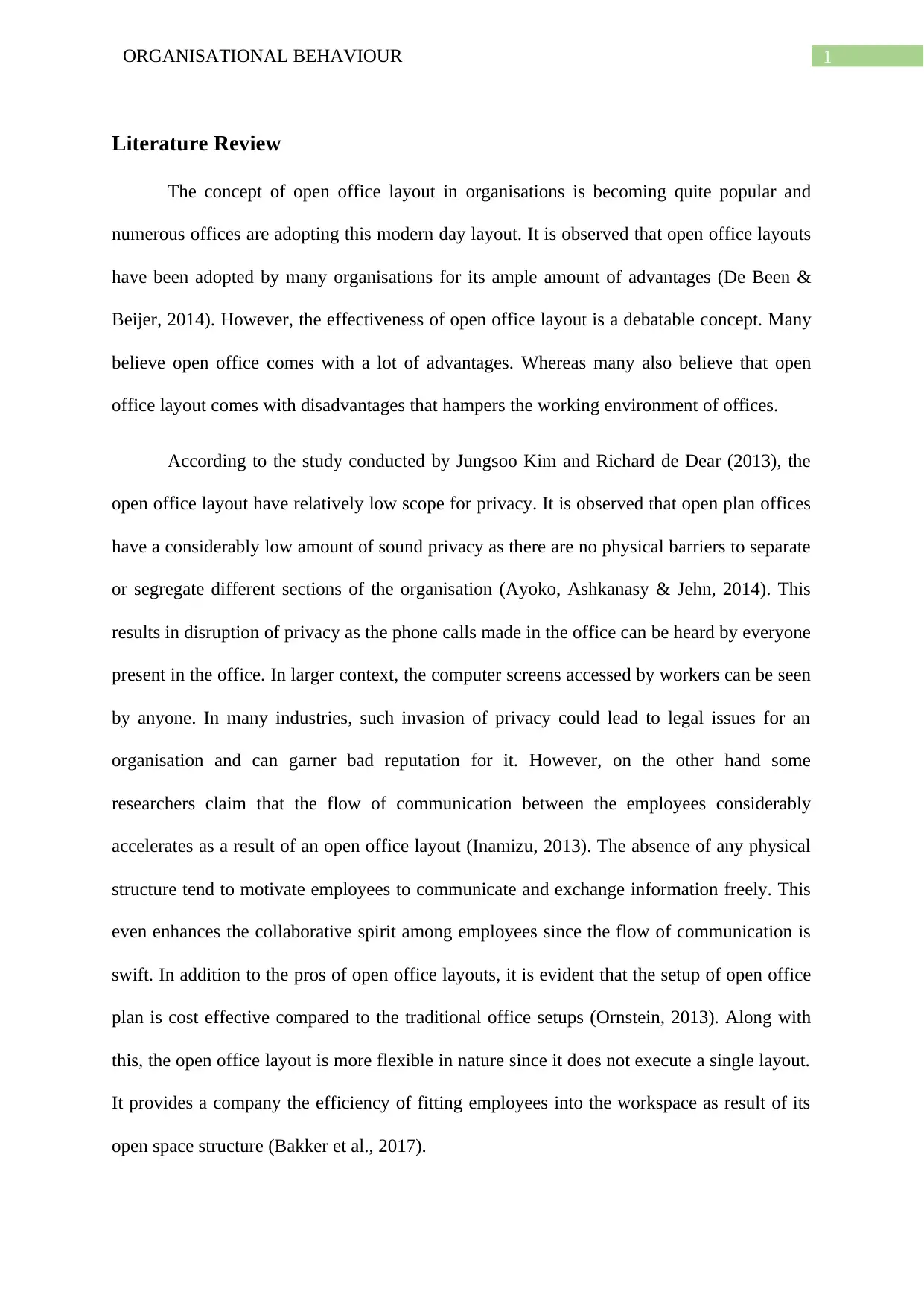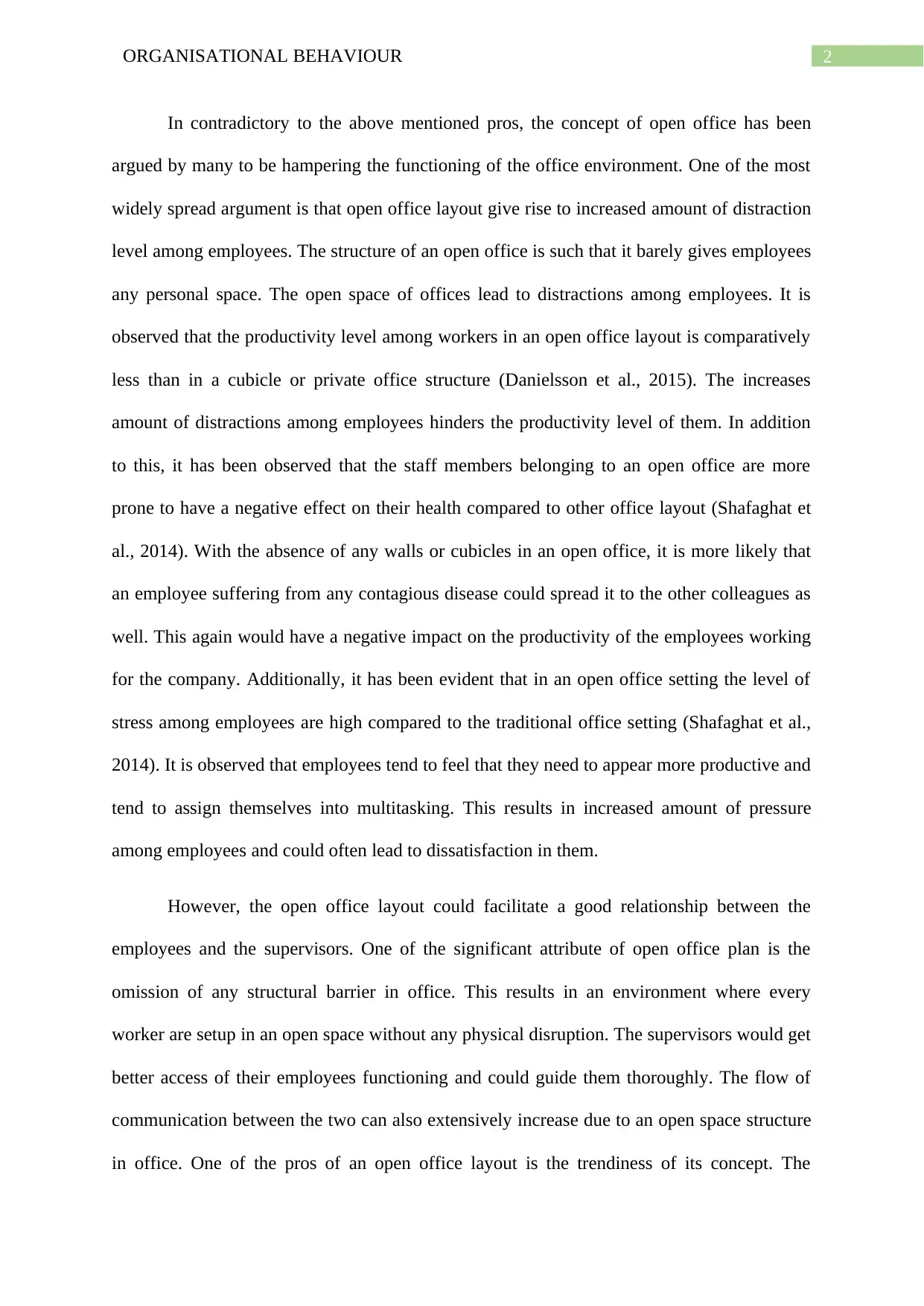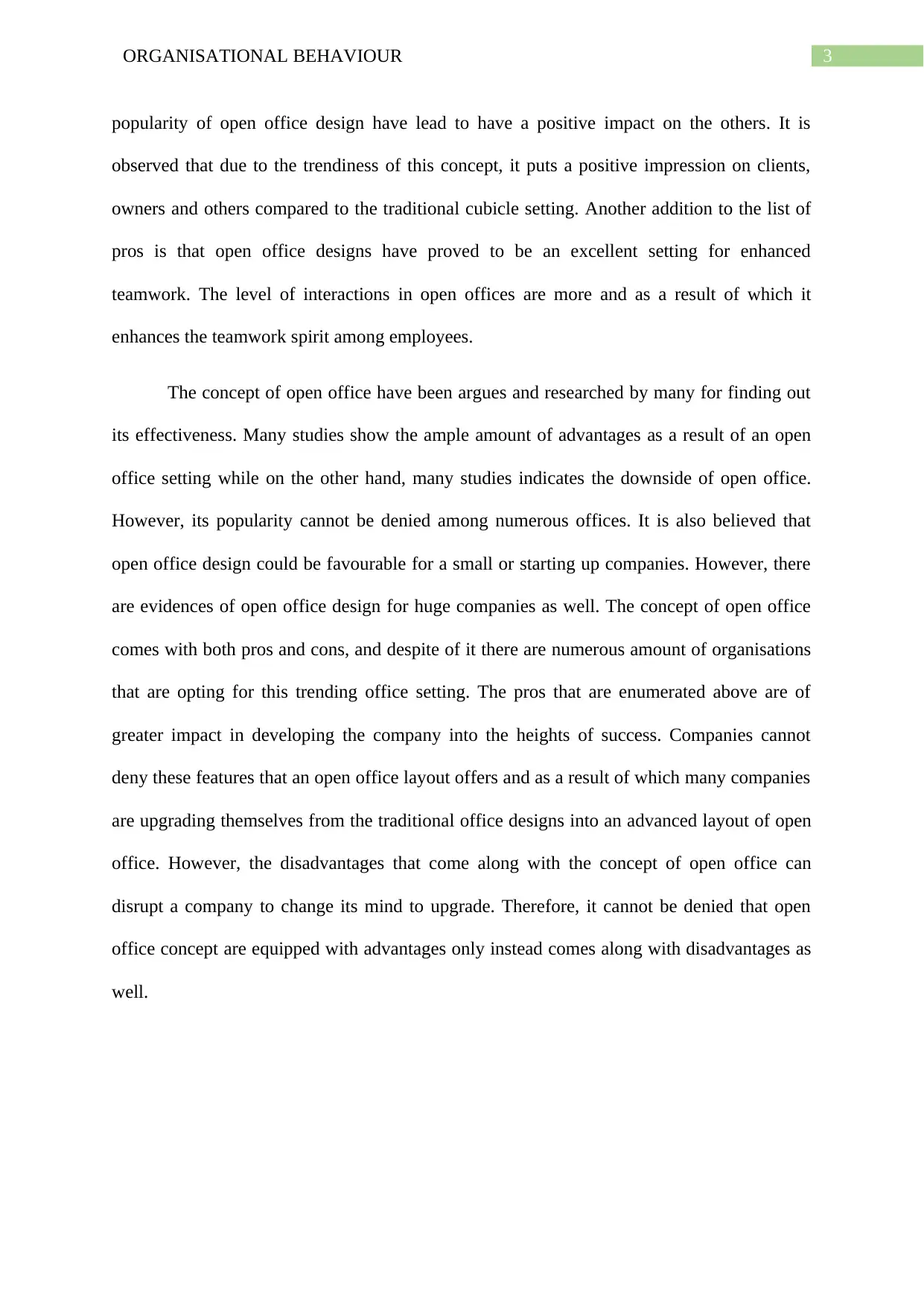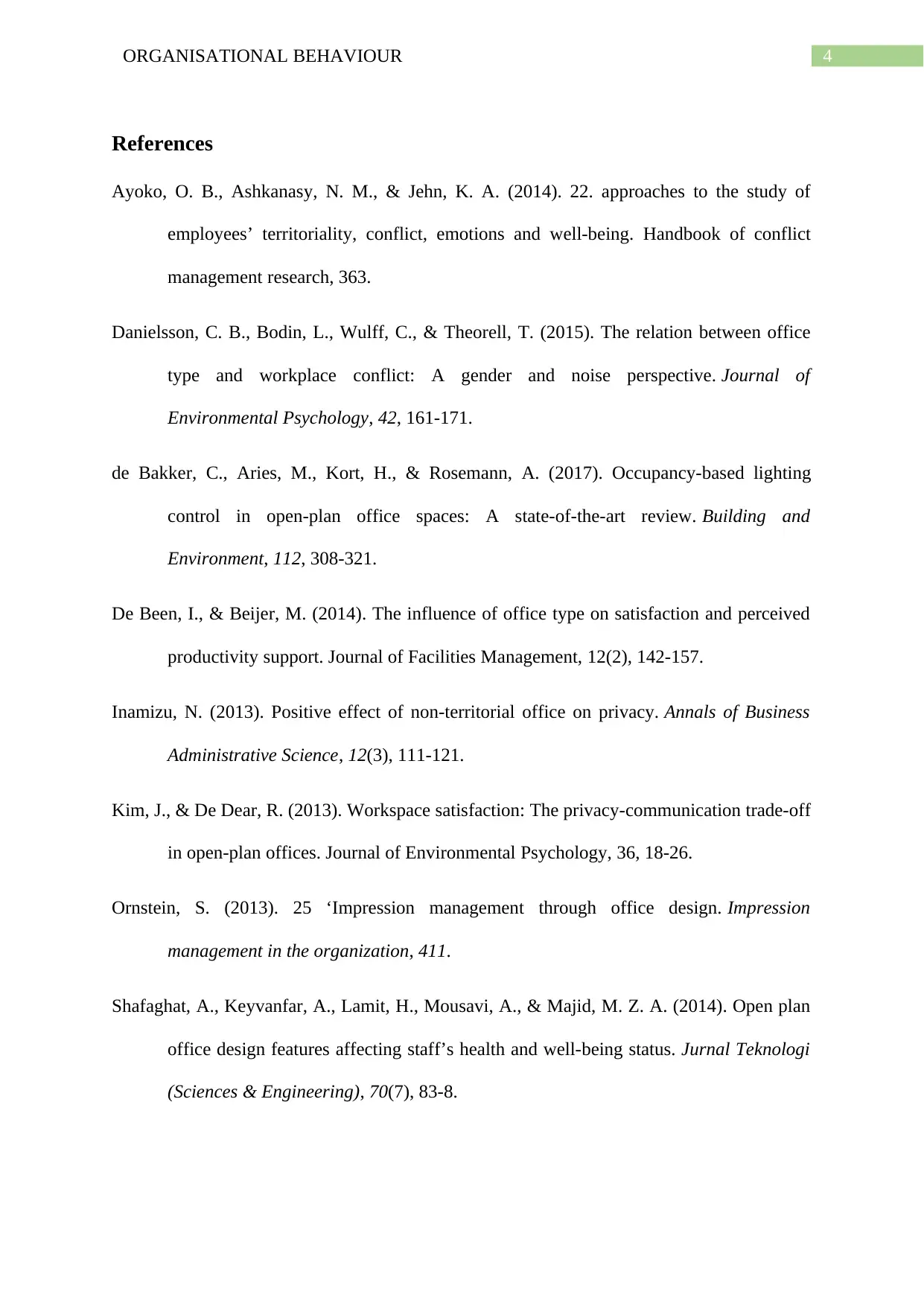Literature Review: Advantages and Disadvantages of Open Office Layout
VerifiedAdded on 2023/06/07
|5
|1444
|399
Literature Review
AI Summary
This literature review explores the increasingly popular concept of open office layouts in organisations, examining both their advantages and disadvantages. The review highlights the benefits, such as enhanced communication and cost-effectiveness, while also addressing concerns related to privacy, distractions, and potential negative impacts on employee health and stress levels. Drawing on various studies, the review analyzes the impact of open office designs on productivity, teamwork, and the relationship between employees and supervisors. It also considers the trendiness of open office layouts and their potential suitability for different types of companies, ultimately concluding that open office designs present both opportunities and challenges for organisations. The review references several research papers to support its claims, providing a comprehensive overview of the current understanding of open office layouts and their effectiveness. This document is available on Desklib, a platform providing study resources for students.

Running head: ORGANISATIONAL BEHAVIOUR
Organisational behaviour
Name of the student:
Name of the University:
Author note:
Organisational behaviour
Name of the student:
Name of the University:
Author note:
Paraphrase This Document
Need a fresh take? Get an instant paraphrase of this document with our AI Paraphraser

1ORGANISATIONAL BEHAVIOUR
Literature Review
The concept of open office layout in organisations is becoming quite popular and
numerous offices are adopting this modern day layout. It is observed that open office layouts
have been adopted by many organisations for its ample amount of advantages (De Been &
Beijer, 2014). However, the effectiveness of open office layout is a debatable concept. Many
believe open office comes with a lot of advantages. Whereas many also believe that open
office layout comes with disadvantages that hampers the working environment of offices.
According to the study conducted by Jungsoo Kim and Richard de Dear (2013), the
open office layout have relatively low scope for privacy. It is observed that open plan offices
have a considerably low amount of sound privacy as there are no physical barriers to separate
or segregate different sections of the organisation (Ayoko, Ashkanasy & Jehn, 2014). This
results in disruption of privacy as the phone calls made in the office can be heard by everyone
present in the office. In larger context, the computer screens accessed by workers can be seen
by anyone. In many industries, such invasion of privacy could lead to legal issues for an
organisation and can garner bad reputation for it. However, on the other hand some
researchers claim that the flow of communication between the employees considerably
accelerates as a result of an open office layout (Inamizu, 2013). The absence of any physical
structure tend to motivate employees to communicate and exchange information freely. This
even enhances the collaborative spirit among employees since the flow of communication is
swift. In addition to the pros of open office layouts, it is evident that the setup of open office
plan is cost effective compared to the traditional office setups (Ornstein, 2013). Along with
this, the open office layout is more flexible in nature since it does not execute a single layout.
It provides a company the efficiency of fitting employees into the workspace as result of its
open space structure (Bakker et al., 2017).
Literature Review
The concept of open office layout in organisations is becoming quite popular and
numerous offices are adopting this modern day layout. It is observed that open office layouts
have been adopted by many organisations for its ample amount of advantages (De Been &
Beijer, 2014). However, the effectiveness of open office layout is a debatable concept. Many
believe open office comes with a lot of advantages. Whereas many also believe that open
office layout comes with disadvantages that hampers the working environment of offices.
According to the study conducted by Jungsoo Kim and Richard de Dear (2013), the
open office layout have relatively low scope for privacy. It is observed that open plan offices
have a considerably low amount of sound privacy as there are no physical barriers to separate
or segregate different sections of the organisation (Ayoko, Ashkanasy & Jehn, 2014). This
results in disruption of privacy as the phone calls made in the office can be heard by everyone
present in the office. In larger context, the computer screens accessed by workers can be seen
by anyone. In many industries, such invasion of privacy could lead to legal issues for an
organisation and can garner bad reputation for it. However, on the other hand some
researchers claim that the flow of communication between the employees considerably
accelerates as a result of an open office layout (Inamizu, 2013). The absence of any physical
structure tend to motivate employees to communicate and exchange information freely. This
even enhances the collaborative spirit among employees since the flow of communication is
swift. In addition to the pros of open office layouts, it is evident that the setup of open office
plan is cost effective compared to the traditional office setups (Ornstein, 2013). Along with
this, the open office layout is more flexible in nature since it does not execute a single layout.
It provides a company the efficiency of fitting employees into the workspace as result of its
open space structure (Bakker et al., 2017).

2ORGANISATIONAL BEHAVIOUR
In contradictory to the above mentioned pros, the concept of open office has been
argued by many to be hampering the functioning of the office environment. One of the most
widely spread argument is that open office layout give rise to increased amount of distraction
level among employees. The structure of an open office is such that it barely gives employees
any personal space. The open space of offices lead to distractions among employees. It is
observed that the productivity level among workers in an open office layout is comparatively
less than in a cubicle or private office structure (Danielsson et al., 2015). The increases
amount of distractions among employees hinders the productivity level of them. In addition
to this, it has been observed that the staff members belonging to an open office are more
prone to have a negative effect on their health compared to other office layout (Shafaghat et
al., 2014). With the absence of any walls or cubicles in an open office, it is more likely that
an employee suffering from any contagious disease could spread it to the other colleagues as
well. This again would have a negative impact on the productivity of the employees working
for the company. Additionally, it has been evident that in an open office setting the level of
stress among employees are high compared to the traditional office setting (Shafaghat et al.,
2014). It is observed that employees tend to feel that they need to appear more productive and
tend to assign themselves into multitasking. This results in increased amount of pressure
among employees and could often lead to dissatisfaction in them.
However, the open office layout could facilitate a good relationship between the
employees and the supervisors. One of the significant attribute of open office plan is the
omission of any structural barrier in office. This results in an environment where every
worker are setup in an open space without any physical disruption. The supervisors would get
better access of their employees functioning and could guide them thoroughly. The flow of
communication between the two can also extensively increase due to an open space structure
in office. One of the pros of an open office layout is the trendiness of its concept. The
In contradictory to the above mentioned pros, the concept of open office has been
argued by many to be hampering the functioning of the office environment. One of the most
widely spread argument is that open office layout give rise to increased amount of distraction
level among employees. The structure of an open office is such that it barely gives employees
any personal space. The open space of offices lead to distractions among employees. It is
observed that the productivity level among workers in an open office layout is comparatively
less than in a cubicle or private office structure (Danielsson et al., 2015). The increases
amount of distractions among employees hinders the productivity level of them. In addition
to this, it has been observed that the staff members belonging to an open office are more
prone to have a negative effect on their health compared to other office layout (Shafaghat et
al., 2014). With the absence of any walls or cubicles in an open office, it is more likely that
an employee suffering from any contagious disease could spread it to the other colleagues as
well. This again would have a negative impact on the productivity of the employees working
for the company. Additionally, it has been evident that in an open office setting the level of
stress among employees are high compared to the traditional office setting (Shafaghat et al.,
2014). It is observed that employees tend to feel that they need to appear more productive and
tend to assign themselves into multitasking. This results in increased amount of pressure
among employees and could often lead to dissatisfaction in them.
However, the open office layout could facilitate a good relationship between the
employees and the supervisors. One of the significant attribute of open office plan is the
omission of any structural barrier in office. This results in an environment where every
worker are setup in an open space without any physical disruption. The supervisors would get
better access of their employees functioning and could guide them thoroughly. The flow of
communication between the two can also extensively increase due to an open space structure
in office. One of the pros of an open office layout is the trendiness of its concept. The
⊘ This is a preview!⊘
Do you want full access?
Subscribe today to unlock all pages.

Trusted by 1+ million students worldwide

3ORGANISATIONAL BEHAVIOUR
popularity of open office design have lead to have a positive impact on the others. It is
observed that due to the trendiness of this concept, it puts a positive impression on clients,
owners and others compared to the traditional cubicle setting. Another addition to the list of
pros is that open office designs have proved to be an excellent setting for enhanced
teamwork. The level of interactions in open offices are more and as a result of which it
enhances the teamwork spirit among employees.
The concept of open office have been argues and researched by many for finding out
its effectiveness. Many studies show the ample amount of advantages as a result of an open
office setting while on the other hand, many studies indicates the downside of open office.
However, its popularity cannot be denied among numerous offices. It is also believed that
open office design could be favourable for a small or starting up companies. However, there
are evidences of open office design for huge companies as well. The concept of open office
comes with both pros and cons, and despite of it there are numerous amount of organisations
that are opting for this trending office setting. The pros that are enumerated above are of
greater impact in developing the company into the heights of success. Companies cannot
deny these features that an open office layout offers and as a result of which many companies
are upgrading themselves from the traditional office designs into an advanced layout of open
office. However, the disadvantages that come along with the concept of open office can
disrupt a company to change its mind to upgrade. Therefore, it cannot be denied that open
office concept are equipped with advantages only instead comes along with disadvantages as
well.
popularity of open office design have lead to have a positive impact on the others. It is
observed that due to the trendiness of this concept, it puts a positive impression on clients,
owners and others compared to the traditional cubicle setting. Another addition to the list of
pros is that open office designs have proved to be an excellent setting for enhanced
teamwork. The level of interactions in open offices are more and as a result of which it
enhances the teamwork spirit among employees.
The concept of open office have been argues and researched by many for finding out
its effectiveness. Many studies show the ample amount of advantages as a result of an open
office setting while on the other hand, many studies indicates the downside of open office.
However, its popularity cannot be denied among numerous offices. It is also believed that
open office design could be favourable for a small or starting up companies. However, there
are evidences of open office design for huge companies as well. The concept of open office
comes with both pros and cons, and despite of it there are numerous amount of organisations
that are opting for this trending office setting. The pros that are enumerated above are of
greater impact in developing the company into the heights of success. Companies cannot
deny these features that an open office layout offers and as a result of which many companies
are upgrading themselves from the traditional office designs into an advanced layout of open
office. However, the disadvantages that come along with the concept of open office can
disrupt a company to change its mind to upgrade. Therefore, it cannot be denied that open
office concept are equipped with advantages only instead comes along with disadvantages as
well.
Paraphrase This Document
Need a fresh take? Get an instant paraphrase of this document with our AI Paraphraser

4ORGANISATIONAL BEHAVIOUR
References
Ayoko, O. B., Ashkanasy, N. M., & Jehn, K. A. (2014). 22. approaches to the study of
employees’ territoriality, conflict, emotions and well-being. Handbook of conflict
management research, 363.
Danielsson, C. B., Bodin, L., Wulff, C., & Theorell, T. (2015). The relation between office
type and workplace conflict: A gender and noise perspective. Journal of
Environmental Psychology, 42, 161-171.
de Bakker, C., Aries, M., Kort, H., & Rosemann, A. (2017). Occupancy-based lighting
control in open-plan office spaces: A state-of-the-art review. Building and
Environment, 112, 308-321.
De Been, I., & Beijer, M. (2014). The influence of office type on satisfaction and perceived
productivity support. Journal of Facilities Management, 12(2), 142-157.
Inamizu, N. (2013). Positive effect of non-territorial office on privacy. Annals of Business
Administrative Science, 12(3), 111-121.
Kim, J., & De Dear, R. (2013). Workspace satisfaction: The privacy-communication trade-off
in open-plan offices. Journal of Environmental Psychology, 36, 18-26.
Ornstein, S. (2013). 25 ‘Impression management through office design. Impression
management in the organization, 411.
Shafaghat, A., Keyvanfar, A., Lamit, H., Mousavi, A., & Majid, M. Z. A. (2014). Open plan
office design features affecting staff’s health and well-being status. Jurnal Teknologi
(Sciences & Engineering), 70(7), 83-8.
References
Ayoko, O. B., Ashkanasy, N. M., & Jehn, K. A. (2014). 22. approaches to the study of
employees’ territoriality, conflict, emotions and well-being. Handbook of conflict
management research, 363.
Danielsson, C. B., Bodin, L., Wulff, C., & Theorell, T. (2015). The relation between office
type and workplace conflict: A gender and noise perspective. Journal of
Environmental Psychology, 42, 161-171.
de Bakker, C., Aries, M., Kort, H., & Rosemann, A. (2017). Occupancy-based lighting
control in open-plan office spaces: A state-of-the-art review. Building and
Environment, 112, 308-321.
De Been, I., & Beijer, M. (2014). The influence of office type on satisfaction and perceived
productivity support. Journal of Facilities Management, 12(2), 142-157.
Inamizu, N. (2013). Positive effect of non-territorial office on privacy. Annals of Business
Administrative Science, 12(3), 111-121.
Kim, J., & De Dear, R. (2013). Workspace satisfaction: The privacy-communication trade-off
in open-plan offices. Journal of Environmental Psychology, 36, 18-26.
Ornstein, S. (2013). 25 ‘Impression management through office design. Impression
management in the organization, 411.
Shafaghat, A., Keyvanfar, A., Lamit, H., Mousavi, A., & Majid, M. Z. A. (2014). Open plan
office design features affecting staff’s health and well-being status. Jurnal Teknologi
(Sciences & Engineering), 70(7), 83-8.
1 out of 5
Related Documents
Your All-in-One AI-Powered Toolkit for Academic Success.
+13062052269
info@desklib.com
Available 24*7 on WhatsApp / Email
![[object Object]](/_next/static/media/star-bottom.7253800d.svg)
Unlock your academic potential
Copyright © 2020–2025 A2Z Services. All Rights Reserved. Developed and managed by ZUCOL.





